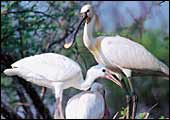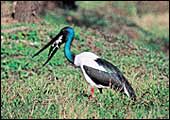|
|
| Winged paradise: Come winter and India
becomes home to flocks of rare migratory birds such as these
bar-headed geese |
|
|
On
a cold Sunday morning, while most level-headed people would rather
not budge out of bed, there is a tribe of people called 'twichers'
(birdwatchers in another tongue) who get up, and armed with notebooks,
binoculars and cameras, head out into the mist. What rouses several
otherwise-pedantic types up on cold mornings is the abundance of
migratory birds that find their way onto the subcontinent escaping
the ever-colder climes up north. The migration of birds has attracted
and aroused man since Homeric times and even finds mention in several
ancient texts. And one would do well to delve into this hobby/passion/obsession
(whatever you choose to call it).
The capital would be a good place to start,
if for nothing else than the fact that it rests on one of the main
migratory flyways for birds. Over 450 different species of birds
visit or make their home in this city. Noted author Bikram Grewal
believes that this makes "the city (Delhi) probably the second
richest city in the world for birds after Nairobi in Kenya".
The area is famous for huge duck and goose flocks, with over 20,000
birds from over 20 species, and wintering gull flocks, which can
number over 10,000. Recently, a sighting of the endangered White
Stork was made by a couple of birdwatchers in the capital.
 |
| Bronze Wing Jacana |
 |
| Asian Spoon Bill |
 |
| Black Neck Stork |
Kolkata too boasts several rare species of birds
as well as great places to watch them. The Nalban water body off
the eastern outskirts of the city, the Maidan and the Botanical
Gardens make for great walks any time of the year. Santragachi jheel
in Howrah is a good place to catch migratory waterfowl. The Western
Ghats is a biological hotspot, with over 500 species making their
home on the southern reaches of the hills in Kerala. On the other
side of the hills, in the city of Bangalore, bird-watching is quickly
catching on-the latest hotspot being close to iim-Bangalore off
Bannerghatta Road.
Across the border in Chennai, twitching is an
established passion. The Guindy National Park, the Nanmangalam Reserve
Forest in Medavakkam, the Indian Institute of Technology (IIT) in
Guindy, the Central Polytechnic, the Matscience Institute on the
Canal Bank Road in Taramani, the Adyar Estuary, the Theosophical
Society in Adyar, the Simpson Industrial Estate in Sembium, the
Madras Christian College in Tambaram, the Manali and Madhavaram
jheels, and the Velachery marsh are excellent bird habitats where
the twichers of Chennai flock together. At IIT, one can see large
groups of open-billed storks, black-winged stilts and other wader
species.
At the other port metropolis of Mumbai, one
can see greater flamingoes in Bombay Harbour. The 15-acre Sewri
Mangrove Park is now home to a few thousand flamingoes, red shanks
and pied avocets, among others. If one ventures a bit further, the
Borivali National Park is also a superb bird habitat and home to
over 250 species. India is a bird watchers' paradise, and if you
are interested in joining the tribe, you could look up some of these
books-A Birdwatchers' Guide to India, Pocket Guide to the Birds
of the Indian Subcontinent and A Field Guide to the Birds of India.
The following websites will give you a headstart-www.delhibird.org,
www.orientalbirdclub.org, www.kolkatabirds.com, www.birdskerala.com,
www.indiabirds.com and www.bnhs.org.
-Ananda Banerjee
TREADMILL
ONE-SIDED EXERCISES
 A
common objective of weight-training and cardiovascular exercises
is to get a well-proportioned, symmetrically balanced body. Still,
as many fitness enthusiasts discover, sometimes things can go awry.
It is not unusual to find right-handed people develop stronger and
bigger muscles on the right side of their bodies compared to the
left. A reader, Rajneesh Kumar, writes about how weight-training
appears to have made the biceps, triceps and pectorals of the right
side of his body more developed than those on the left, and wonders
whether he can set things straight. Of course he can, but before
solving his problem, let's quickly see why this happens to many
of us. A
common objective of weight-training and cardiovascular exercises
is to get a well-proportioned, symmetrically balanced body. Still,
as many fitness enthusiasts discover, sometimes things can go awry.
It is not unusual to find right-handed people develop stronger and
bigger muscles on the right side of their bodies compared to the
left. A reader, Rajneesh Kumar, writes about how weight-training
appears to have made the biceps, triceps and pectorals of the right
side of his body more developed than those on the left, and wonders
whether he can set things straight. Of course he can, but before
solving his problem, let's quickly see why this happens to many
of us.
Most of us aren't ambidextrous and are either
right-handed (most of us are) or left-handed (some of us are). This
usually means that the right (or left) hand performs more actions
or movements in the course of everyday living. As a consequence,
the muscles on one arm or side of the body get more developed. It
is possible that the imbalance can get more pronounced with weight-training
because one arm is able to perform better during exercise than the
other. For instance, while bench-pressing a barbell, many right-handed
people feel they are lifting the bar predominantly with their right
arms, while the left assists in bringing up the slack. Ditto for
barbell biceps curls or triceps exercises where both arms are used
together-like the triceps pull-down.
One solution is to temporarily stop doing exercises
that require simultaneous and similar use of both arms and go in
for isolateral (or one-sided) exercises. For instance, instead of
barbell bench presses, go in for bench presses using a dumb-bell
in each hand. Also, you could alternate the movements of each arm;
instead of pressing both dumb-bells upwards together, push each
arm separately, alternating between the two. Likewise, instead of
barbell arm curls for your biceps, do dumb-bell curls. For good
measure, do two or three more repetitions for your weaker arm to
induce the muscles on that side to develop stronger.
Tip of the fortnight: Here's a quick-fix remedy
for shin pain, an affliction that many runners (particularly those
who run on hard surfaces) can experience. Stand on a step with your
heels on the edge of the step (a block of wood or a brick will do
as well). Now, point your toes down and feel the stretch along the
front of your leg. Do a couple of 10-rep sets. Follow it up by soaking
your legs in a bucket or tub of hot water. If, however, your shin
pain is unbearable or it persists, go see an orthopaedist. It could
be more serious than just stress.
-Muscles
Mani
write to musclesmani@intoday.com
FOOD
FOR YOUR BRAIN
Before
your eyes light up, let's make one thing clear: there's no magic
potion for the human brain, to improve memory, intelligence, even
your ability to learn. But the brain is, after all, an organ like
any other, and some nutrients nourish it more than others. Here's
a primer:
Over the ages: Ancient Egyptians believed that
fish was good for the brain, a belief that was reinforced in 19th-century
Europe, simply due to the presence of phosphorus in both fish and
the brain. Our own Vedic medicine, on the other hand, prescribes
a wide range of nourishing nutrients for improving the brain's functions.
Walnuts, ostensibly because it resembles the brain, were viewed
as brain food. Then, ghee is another food that is highly spoken
of in Ayurveda as good for the brain. Herbs such as Brahmi, Gotu
Kola and Aloeweed are also said to assist in sharpening learning
ability, memory and recall. All these are ancient beliefs, and have
not been proven clinically.
Today's shopping list: Dr. Bipin Walia, Neurosurgeon,
Max Healthcare, says, "Foods rich in iron, B vitamins and antioxidants
help the brain get plenty of oxygen and energy, and get rid of damaging
free radicals." The doc recommends whole-grain cereal, peanut
butter, non-fat milk, lean red meat, cooked dried beans, spinach,
orange juice, berries and carrots to stimulate the juices of your
grey matter.
One ancient wisdom doesn't change though: healthy
eating habits are as important as healthy food. So, take your food
on time, every time, and keep indulgences like fatty foods and junk
food to a minimum. That should work like a potion. For the brain,
and all else.
-Alia Ramaswamy
|
